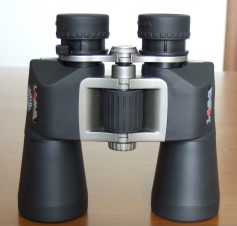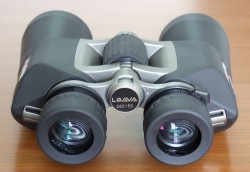

Binoculars of 10x50 are excellent multi-purpose hand held devices. Although being less compact and mobile than typical 42mm roof prism types, these 10x50 glasses have an additional performance margin under low light and for astro applications. Since 10x50 binoculars of Porro design and decent performance are comparably inexpensive, they are scoring high on the ranking list of binoculars 'best buys'. Inside China, LOAVA is a popular brand name, offering a large selection of different binoculars. The present review is comparing two China made 10x50 Porro type binoculars, which, under various different brand names, are also frequently found outside of China.
Fig. 1: The LOAVA 10x50 HG with central focus (CF)
This binocular has got no particular type name printed on it, so I simply refer to it as 'HG (CF)' because of its central focuser. 'HG' stands for 'High-Grade'. It is a well built waterproof and nitrogen filled binocular with comfortable twist up eye-cups. As can be seen on the picture (right), there is a lot of grease used to lubricate the twist up cups, and this is sometimes causing trouble to the ocular-lens. This instrument has got a central focuser with a big focusing wheel which is reached very comfortable during observation. The focuser is a little sticky, however, and the ocular bridge becomes somewhat tilted while operating the focusing wheel, which makes the focusing procedure less accurate. I found it difficult at times to obtain the perfect focus of star images. The body is made of metal and covered with a rubber skin, delivering an excellent grip under any weather condition.
Fig. 2: The LOAVA 10x50 HG (General), military style
The 'High-grade General' is a military style binocular with individually focusing oculars. In fact, this is the larger brother of the BM2 8x40 binocular which I have tested some time ago. This series is designed to tolerate an extremely rugged treatment, is waterproof, nitrogen filled and has got a shock proof prism mounting. It is very heavy and robust, and the oculars are turning tightly, almost too tight that is. On the other hand, this is a signature for the instrument being really waterproof. The soft rubber eye cups are too long to my taste: When folded up, I cannot see the full field of view. When folded down, my eyes come too close and a kidney-bean effect (blackout) shows up. The body cover appears to be the same as the HG (CF)'s, although a different version with thick rubber armor is available as well.
The following table summarizes some of the specifications of the contenders.
| Real angle | Apparent angle | Eye relief | Exit pupil | Close focus | Weight | |
| of view (deg) | of view (deg) | (mm) | diam. (mm) | (m) | (gram) | |
| LOAVA 10x50 HG (CF) | 6.5 | 65 | 19 | 4.5 | 4 | 1050 |
| LOAVA 10x50 General | 6.5 | 65 | 19 | 4.1 | 6 | 1170 |
The specifications in the table above do already indicate: Both binoculars are using the same eyepiece design, that is why they have identical eye-relief and field of view. As a result, the optical performance of both glasses is very similar. When observing stars at night, the star image is properly point-like near the center and remains so up to little more than 60% towards the edge of field, which, with 65 degrees, is of a pleasant wide angle. During day time observation, the image is bright and without any visible color tint. Stray light resistance of both binoculars is better than average. It appears that the HG (General) has got a slight advantage here, but the difference is subtle. Both have got better stray light protection than the BM2 8x40 I have tested earlier. Similarly, both binoculars display a very good resistance against ghost images, when a bright light source is observed during the night. This is an indication for the quality of coating being quite high, considering the price range of these binoculars.
Less pleasant is the fact that both binoculars have got exit pupils which are smaller than specified: A 10x50 with un-obstructed light train should deliver 5mm exit pupils. The HG (CF) has got 4.5mm, making it effectively a 10x45 binocular, and the HG (General) which I have tested has got only 4.1mm exit pupil. In other words: This is actually a 10x41 binocular, and the reduced size of effective entrance pupil implies a reduced performance under low light. In fact, once the eye-pupils of the observer begin to open up under low light conditions, the HG (CF) is visibly brighter than the HG (General). The light collecting performance depends on the area of effective entrance pupil, and there is a 20% performance difference between both instruments. I have no idea why the 10x50 HG (General) is stopped down to 4.1mm. Surely, it is not because of the prism size, which is properly dimensioned. Also, I have confirmed that the 8x40 version of this binocular has got a correct 5mm exit pupil. During daytime, these effects are a non issue, of course, but at low light both binoculars, the HG (CF) and, more so, the HG (General), are suffering a performance loss.
Despite of their reduced exit pupils, these binoculars offer a lot for their money. Both of them have got a robust and weather-proof construction, wide field of view, quality coating and effective stray light protection. For general use, I would prefer the HG (CF), which has got the more comfortable focuser and eye-cups, is less heavy, offers a shorter close-focus and an advantage at low light. If the conditions become more rugged, then the HG (General) has got the advantage of being more robust. It has also got a slight advantage in stray light resistance, and the focuser is more accurate than the central focuser of the HG (CF). This is also of relevance for astro applications, where the focus remains fixed at infinity, so that the inconvenience of individual focusing becomes less important.
Holger Merlitz: merlitz@gmx.de
Last updated: May 2007